Original URL: https://www.theregister.com/2009/10/01/inside_intels_moorestown/
Inside Intel's 'Moorestown'
Can Atom 2.0 get into smartphones?
Posted in Personal Tech, 1st October 2009 12:02 GMT
The next major version of Intel's Atom is expected to debut early next year. It's part of the 'Pine Trail' platform, the chip giant's offering for netbooks, which typically use Atom N-series CPUs. But it's not the only Atom upgrade due next year. Six months or so later, Intel will release 'Moorestown', its new platform for mobile internet devices (MIDs) - kit that is currently based on the Atom Z series of processors.
Intel hasn't said much about Pine Trail beyond its integration of CPU, memory controller and graphics core into a single chip. You can read about Pine Trail in our Whizz for Atomms feature here.
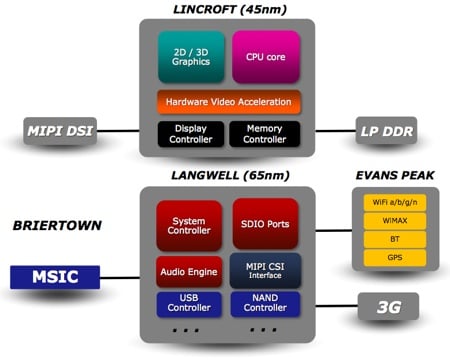
Inside Intel's 'Moorestown'
More has been said about Moorestown, especially at the recent Intel Developer Forum. While netbooks are likely to be far more readily available in 2010 than MIDs, Moorestown is more intriguing than Pine Trail because it marks Intel's first realistic attempt to enter the smartphone arena and because it incorporates some interesting technology to not only boost performance but also to radically reduce power consumption.
Given their common origins - both contain the same, 'Bonnell' processor core design, for example - Pine Trail and Moorestown may well share these performance-per-Watt traits, so Intel may be revealing more about Pine Trail than it's letting on.
Like Pine Trail, Moorestown comprises two chips, though in fact there's a third piece to this puzzle. The well-known ones are 'Lincroft', the CPU+ component, and 'Langwell', the I/O chip. But there's also 'Briertown', which is a much more basic slice of silicon but no less important to achieving the platform's goals.
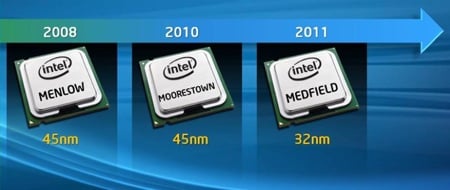
What comes next? Beyond Medfield, Intel's not saying
Intel wants Moorestown to deliver a significant reduction in power consumption - read 'big improvement in battery life' - without compromising performance. The space taken up by the chips and connecting circuitry has to be smaller than previous MID platforms, specifically the current one, 'Menlow' - an Atom Z CPU combined with the UL11L, US15L or US15W chipset - too.
Intel claims that, on average, Moorestown will consume less than half the power that Menlow does, but the real boost comes to the amount of power it uses up while on stand-by - one fiftieth of Menlow's idle power consumption, the company claims.
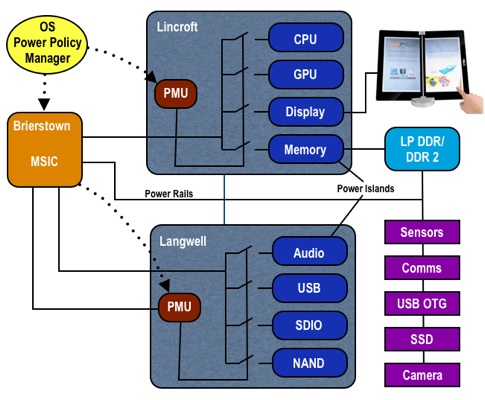
Moorestown's 'fine-grain' power management
Menlow consumes 1.6W in stand-by, putting Moorestown at around 32mW.
That, Intel hopes, will be sufficient to allow, say, a high-end smartphone to run for a day or two between charges, depending on usage.
The level of stand-by power consumption is central to Moorestown's design philosophy. And it's not only about keeping the power loss right down while the host device isn't doing anything. Moorestown was also designed to get as much work done in as little time as possible in order to get the device back into that ultra-low power idle state as soon as it can.
Lincroft's contribution to that is manifold. The CPU core, which is essentially an existing 'Silverthorne' Atom, is accompanied in the package by a 2D/3D graphics engine, a memory controller, a video decoder and encoder, and the display controller.
All of these components are managed by an on-chip Power Management Unit (PMU) that can completely switch off any of them that aren't being used at a given moment. Moorestown uses pre-programmed power usage policies that govern what gets switched off and when. If the handset's screen is off, for example, the display controller, video and graphics engines can be powered down.
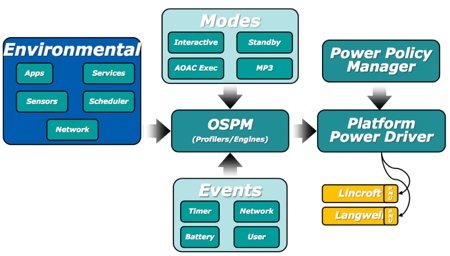
Moorestown's power management systems' interplay
If you're listening to music, off goes the CPU too while Langwell's audio engine handles the work. Alongside that component, Langwell is home to Moorestown's embedded, SDIO, USB, NAND Flash - ie. storage - and camera controllers. There's no PCI Express - that's too PC-centric and not needed here, says Intel, though it will be a part of Pine Trail's 'Tiger Point' I/O chip - with all other peripherals, such as Intel's own Wi-Fi, Bluetooth and GPS module, 'Evans Peak', connecting over the SDIO bus. Intel has added a CE-ATA bus too, presumably with an eye on set-top box opportunites.
While Lincroft is fabbed at 45nm, Langwell is a 65nm part, though their packages are effectively identical in size.
Brierstown connects to Langwell and is what Intel calls a Mixed Signal Integrated Circuit (MSIC). It's something of a grab bag of parts. For instance, it houses Moorestown's audio codec circuitry and the touchscreen controller. It also integrates a lot of lesser electronic components - clock chips and the like - which helps keep Moorestown's overall size down. Menlow required up to 800 of these chips, capacitors and so on, depending on configuration. Many of them are a result of its PC-oriented past. Moorestown, with its handheld-specific design and level of integration gets these power consumers down to half that total.

Power gating allows entire sections of chip to be turned off
A compact Menlow motherboard comes in at around 8500sq mm - a Moorestown board should be half that: 4250sq mm. Future platforms, most notably 2011's 32nm 'Medfield', should reduce that even further, perhaps down to 2833sq mm.
Bringing these into Briertown reduces size and power consumption, but the MSIC's real contribution to Moorestown's power characteristics is as the system's main power monitor and arbiter. It takes the feed from the system's temperature sensors - those in the host device, and those in Langwell and Lincroft - and, on the basis of the power management policies, tells Lincroft's PMU what components to close down and to re-activate.
Langwell also has its own PMU, and Briertown directs that too, again powering down islands of functionality that are not currently needed then re-energising them when they are.
That temperature information can be used to do some clever performance-boosting tricks. If Lincroft's CPU is under load but the chip's overall thermal output is below TDP - perhaps because the video and graphics engines have been powered down - Brierstown can tell Lincroft's PMU to push up the CPU core's operating frequency and voltage.
The result is a burst of performance - in excess of 1GHz, Intel has said - that gets the CPU job done more quickly. When the task is complete, the OS' power management system can send the CPU back into an idle state.
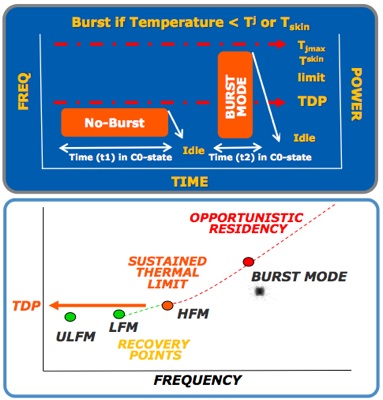
Burst Mode: boosting Moorestown's CPU speed for better battery life
Intel reckons it's better to take a quick hit on power consumption by dynamically overclocking Lincroft's CPU when appropriate - it'll do so for just a few milliseconds at a time, says Intel - than to keep the CPU running a task for longer but at a slightly lower frequency. The sooner it can get the chip back to an idle, powered down state, the longer the battery will last.
That's why Lincroft has special video decode and encoding engine. Previous platforms left that kind of task to the CPU, but the dedicated circuitry and perform the same task with less of a strain on the battery, allowing the CPU to be kept powered down.
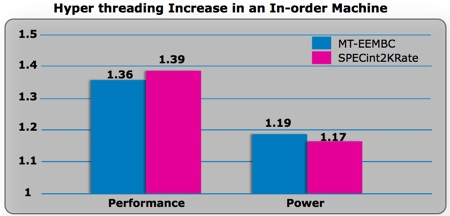
HyperThreading advantage: performance gain outweighs rising power draw
Figures relative to normalised single-core scores
Moorestown also has Bus Turbo mode that follows the CPU core burst mode to up the memory bus frequency in order to reduce latency to get data to the processor as fast as possible, again making for a more speedy completion of the task at hand.
Dozens of usage scenarios inform the power management polices that govern what elements Moorestown can safely switch off at any given moment. If the CPU core can't be shut down, the power management system aggressively targets the lowest possible clock frequency and voltage combination that it can get away with.
How well it will work in the real world remains to be seen - Moorestown won't ship until mid-2010, and devices based upon it won't be available for the best part of a year from now - but compared to Menlow, the power savings are significant, intel claims.
Playing a 720p HD video on a Moorestown consumes a third of the power it does on Menlow. Video playback does require a little CPU work - audio playback doesn't and here the power reduction is a whopping 25-fold. Intel hasn't published actual mW figures, but its comparison chart (above) shows Moorestown's music power demand is tiny compared to Menlow's.
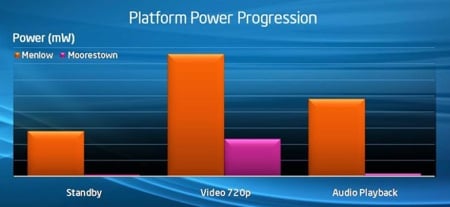
Power savings: Moorestown vs Menlow
In addition to burst mode, Lincroft's CPU once again has HyperThreading, allowing the OS to schedule an extra thread to run in parallel with the current one, if the necessary CPU resources are available.
Pulling the graphics core from the chipset into Lincroft doubles the 2D and 3D performance, the chip maker claims, while reducing power consumption. Again, that's by reducing the need for expensive - in power terms - CPU cycles.
The graphics core will support not only OpenGL ES 2.0 but also OpenVG 1.0, the vector graphics acceleration API.
Other design choices will help device makers reduce power consumption further. For example, Lincroft's display controller supports the LVDS (Low-Voltage Differential Signalling) used to run most of today's notebook screens. But it also supports the newer MIPI (Mobile Industry Processor Interface) Display Serial Interface bus, which consumes 125mW less than LVDS.
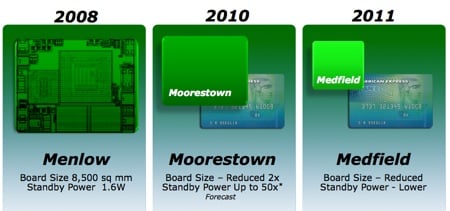
Honey, I shrank the chips
Likewise, while Lincroft's memory controller will support DDR 2 - for PC-style devices, says Intel, even though it's removed other PC-centric technologies from the platform - it also supports low-voltage DDR memory for better power consumption. In both cases, memory connects over a single channel.
Intel has admitted that its figures for Moorestown's power advantage over Menlow assume the use of MIPI-connected peripherals - the camera controller uses the same bus technology - so vendors who use LVDS displays won't be allowing Moorestown to do its best to conserve power. But LVDS has to be there because of the sheer number of LVDS screens on the market and the paucity of MIPI devices.
And it has said that Flash content playback will still be handled by the CPU, which could hit battery life hard given how many websites rely on Flash. This is one reason why Flash is absent from the iPhone, and may come to bite Intel - always keen to stress how Flash friendly its platforms are - hard.
Real-world usage will be the real test of Intel's claims for Moorestown. Unfortunately, we have a long wait before we can see how well Intel's design team has met the challenge. ®